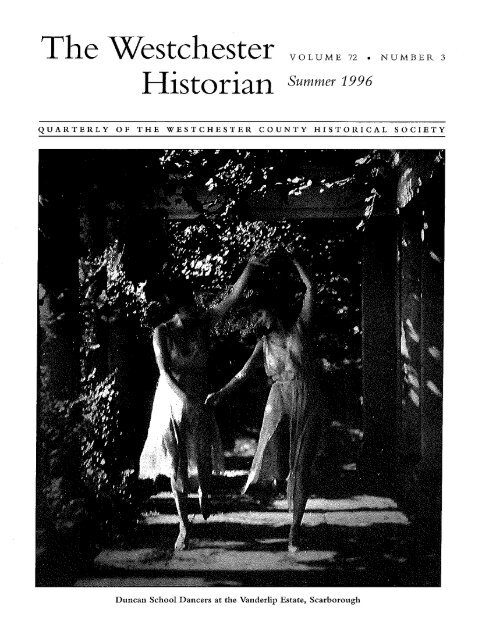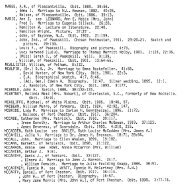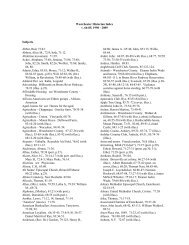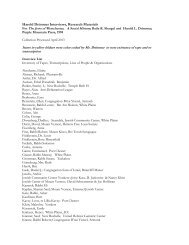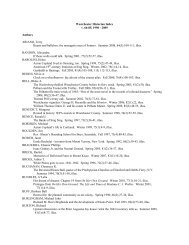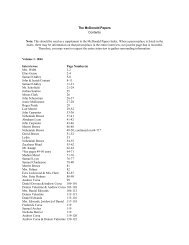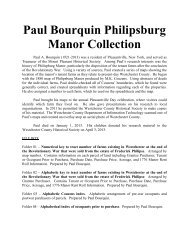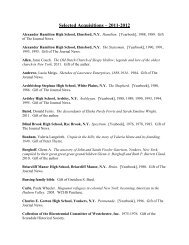Isadora Duncan.pdf - Westchester Historical Society
Isadora Duncan.pdf - Westchester Historical Society
Isadora Duncan.pdf - Westchester Historical Society
You also want an ePaper? Increase the reach of your titles
YUMPU automatically turns print PDFs into web optimized ePapers that Google loves.
The <strong>Westchester</strong> 72 .<br />
Historian Summer 1996<br />
QUARTERLY OF THE WESTCHESTER COUNTY HISTORICAL SOCIETY<br />
<strong>Duncan</strong> School Dancers at the Vat~derlip Estate, Scarborough
The <strong>Isadora</strong> <strong>Duncan</strong> Influence in <strong>Westchester</strong><br />
Jane Northshield<br />
<strong>Isadora</strong> <strong>Duncan</strong> could mesmerize the most sophisticated<br />
theater-going audiences in the world. She was<br />
the darling of high society, and the leading artists of the<br />
early twentieth century had portfolios of sketches and<br />
photographs, their efforts to capture the essence of this<br />
new dancing genius. Every detail of her private life was<br />
made public fodder throughout Europe and America.<br />
<strong>Isadora</strong> had reached the peak ofher career when war<br />
began in Europe in 1914, and, with other Americans,<br />
she was urged to return to the United States. Before<br />
she left Paris the children were brought over. The<br />
children were 15 young German girls from the school<br />
she and her sister had established in Germany The<br />
people in <strong>Westchester</strong> who had known and admired<br />
<strong>Isadora</strong> in Europe took in the children and helped to<br />
reestablish the school. They were not ordinary children<br />
arriving on ordinary doorsteps.<br />
There was never anything ordinary about <strong>Isadora</strong>.<br />
She was born in 1878 (new evidence now says 1877)<br />
in San Francisco, fourth in a family of four. Her father<br />
soon left the fanlily, and her mother gave music lessons<br />
to support her two girls and two boys. They grew<br />
closer than most families, held together by their poverty,<br />
their love of music and dance and theater, and their<br />
ambition. <strong>Isadora</strong> and her sister, Elizabeth, taught<br />
themselves to dance and began teaching others in their<br />
dance classes by the time they were teenagers. It<br />
became obvious that if there was to be a "star" in the<br />
family it would be <strong>Isadora</strong>. She was a member of a<br />
theater troupe for a few years; then, when she was 20,<br />
the family opened a dance studio in NewYork. Unable<br />
to find success there, they decided to move to London.<br />
In London they lived by their wits, often deeply in<br />
debt but able to talk their way out of any real tro~~ble.<br />
<strong>Isadora</strong> was energetic, opportunistic and always fun to<br />
be with, but most of all she had great personal charm,<br />
charisma, and a "way" with influential older men.<br />
Having had few dancing lessons, she had developed her<br />
own style of natural dance. She became known in<br />
London because she was attractive and unusual. In a<br />
world of corsets and long gowns, she became a<br />
sensation in her gauze tunic and bare feet.<br />
The next move for the <strong>Duncan</strong> family was to Paris.<br />
Success in London had been only with the very<br />
wealthy in their salons and at their garden parties. In<br />
Paris she was embraced by the artists, writers, musicians<br />
and theater people, and here she was recognized as an<br />
artist. This is an oversimplification of her life. She had<br />
successes and failures, passionate love affairs and terrible<br />
tragedies. She was demanding and arrogant and<br />
charming and generous. She traveled and danced<br />
throughout Europe, from yachts on the Kiviera to<br />
workmen's halls in Russia. All of this implies that she<br />
was a fad--a charming fad with a gimmick. If this<br />
were so she would have faded without a trace. She<br />
was, instead, a rare genius who brought a new form of<br />
dance into the world. It was the beginning of modern<br />
dance and the time was right for acceptance.<br />
Stanislavsky was introducing the "method" form of<br />
acting in Russia. Impressionist painting was beginning<br />
to be accepted and Cubism was being explored. In<br />
1905 Isador; and Elizabeth <strong>Duncan</strong> opened their<br />
School of the Arts in Grunewald, a suburb of Berlin,<br />
Germany.<br />
The school was a dream and constant aim of both<br />
sisters. Elizabeth always remained in the background,<br />
helping when she was needed. She seemed to<br />
relinquish her own ambition in favor of <strong>Isadora</strong>'s, but<br />
they wrre ve~y close and their needs and ambitions<br />
were intertwined.<br />
On opening the first school in the elite section of<br />
Berlin, they advertised it as a free scl~ool of dance for<br />
girls, ages four to eight. <strong>Isadora</strong> chose 20 from the<br />
crowd of parents and children who appeared the first<br />
day The school's motto was "Beauty, Freedotu and<br />
Health." It was <strong>Isadora</strong>'s belief that if a very young<br />
child grows up in an atmosphere of beauty she will<br />
become beautiful. In her own words:
Many years ago the idea came to me that it<br />
might be possible to bring up young girls in such<br />
an atmosphere of beauty that, in setting continually<br />
before their eyes an ideal figure, their own<br />
bodies would grow to be the personification of<br />
this figure; and that through continual etnulation<br />
of it and by perpetual practice of beautiful movements,<br />
they would become perfect in form and<br />
gesture. (Excerpt from The Art of the Dance)<br />
One of the pupils later described what she remetnbered<br />
of that day She said the mothers and girls were<br />
ushered into a completely blue room.There were several<br />
adults wit11 a lady dressed in a blue robe, reclining<br />
on a blue couch. The children walked around together<br />
in a large circle while they were watched and discussed.<br />
Finally they were all dismissed and told that<br />
they would be notified.<br />
<strong>Isadora</strong> had hoped to find strong financial backing<br />
for the scl~ool but was unable to. This meant that her<br />
dance engagements had to support it, she was seldom<br />
there, and it gradually becatne Elizabeth's school.<br />
Actually a suburb in Germany didn't work for <strong>Isadora</strong>.<br />
The German housewives of 1905 did not have rouge<br />
on their cheeks. Elizabeth was not at all like <strong>Isadora</strong>.<br />
She was small, neat and straight; she was austere and<br />
strict and her pupils were in awe of her. On the other<br />
hand she was protective of her young pupils and she<br />
was reliable, something <strong>Isadora</strong> was not. Near the end<br />
of 1906, as the school was having financial difficulties<br />
and <strong>Isadora</strong> traveled frequently, an Austrian musician<br />
named Max Merz arrived to teach music. He became<br />
a close friend of Elizabeth's and had a strong influence<br />
on how the school was run. He was unpopular with<br />
the pupils, but he did take over the financial problenls,<br />
and convinced the Duke of Hessen-Darmstadt that he<br />
should donate some of his land in Darmstadt,<br />
Germany, and help build a new school. Within a few<br />
years they all moved into the beautiful new school,<br />
called Die Elizabeth <strong>Duncan</strong> Schule. This was it1 1912.<br />
In 1913 <strong>Isadora</strong> had found an establishment in Paris<br />
and wanted a school there. She asked Elizabeth to send<br />
the six oldest girls to her. They were about 16 then and<br />
left for Paris and their adored <strong>Isadora</strong>, all dressed in<br />
their elegant blue matching outfits. A year later the war<br />
in Europe changed everything.<br />
In August of 1914 the German army arrived to take<br />
over the school building in Dartnstadt, and Elizabeth<br />
and the children were given two 11ours to pack up and<br />
get out. Nine of the German pupils went wit11<br />
Elizabeth to London. They had very little money but<br />
were able to find a find a place in steerage on a ship<br />
leaving for America. By coincidence Clifford B.<br />
I-Iarmon, the largest real estate developer in the United<br />
States and the developer of Harmon in Croton, was on<br />
the upper deck of the same ship. Since Harmon kept<br />
a suite at the Ritz in Paris year-round, he probably<br />
knew all about <strong>Isadora</strong> and her pupils. When he heard<br />
the <strong>Duncan</strong> group was in steerage, he insisted that they<br />
should be allowed on the top deck during the day<br />
When they arrived at Ellis Island--Elizabeth with nine<br />
little enemy aliens without passports--their way' was<br />
again stnoothed for them. Frederick C. Howe,<br />
Cotn~nissioner of Immigration, was also a Croton resident<br />
and had met <strong>Isadora</strong>. He allowed them to live in<br />
his private quarters on Ellis Island during the processing<br />
procedure.<br />
So much has been written about <strong>Isadora</strong> and so little<br />
about Elizabeth. Except for Mabel Dodge Luhan's<br />
description of her as a mover-shaker and the scllool in<br />
Croton, and Irma <strong>Duncan</strong>'s obvious dislike of her in<br />
<strong>Duncan</strong> Dnncer, all of tny information comes fiotn people<br />
who were young children when Elizabeth reestablished<br />
her school in <strong>Westchester</strong>. Because of differences<br />
in ~neino~y some things do not fall into place historically,<br />
but in general I believe the following to be accnrate.<br />
The six older girls who had gone with <strong>Isadora</strong> were<br />
established at an estate near Paris. Soon after, <strong>Isadora</strong>S<br />
own two children, born through love affairs with<br />
Gordon Craig and Paris singer, were drowned.<br />
Immediately after the tragedy, <strong>Isadora</strong>'s fanlily took her<br />
to Cotfu. Singer sent the six to his home in London,<br />
and in September Augustin, <strong>Isadora</strong>'s brother, brought<br />
them to the United States. Mr. Howe, the<br />
cotnmissionkr of Inn~ugration, again came to the rescue<br />
and the clddren were eventually guests of the<br />
Simeon Fords at their estate in Rye, on Forest Avenue<br />
and Long Island Sound. Julia Ellsworth Ford was a<br />
patron of the arts, and <strong>Isadora</strong> was welcolned there<br />
when she arrived later in the year.<br />
Elizabeth and her group stopped first at a large<br />
Victorian tnansion, no longer standing, at 360 North<br />
Broadway in Yonkers. This was in August 1914, but<br />
within several months the school had begun again in at1<br />
old €armhouse, at 30 Sunset Drive in Croton, once the<br />
hotne of the caretaker of theVan Cortlandt farm. This<br />
is in the Harmon section of Croton-on-Hudson. Two<br />
people seem to have eased the way for Elizabeth in the<br />
Yonkers-Croton moves--a Mrs. Hansel, a Scandinavian<br />
nurse friend of Elizabeth, and the Frarlk Vanderlips.<br />
FrankVanderlip was president of what is now Citibank<br />
in NewYork. I-Ie and his wife were actively cornnutted<br />
people who loved art in all its forms. The theater called
Beechwood Theater, built on the grounds of their<br />
estate in Scarborough, was modeled after the Little<br />
Theater in NewYork. Some ofArnold Genthe's most<br />
exquisite photographs of the <strong>Duncan</strong> dancers were<br />
taken near the pools and Greek columns of the<br />
Vanderlip grounds. FrankVanderlip Jr. says that all of<br />
the moves made by the Elizabeth <strong>Duncan</strong> School fsom<br />
1914 to 1920 were done with the help of his father and<br />
Harry Shanker, his father's business and real estate<br />
agent. One particular dancer, Ema, was always sponsored<br />
and helped by the Vanderlip family and is still a<br />
close friend of the family<br />
The old farmhouse in Croton apparently was not<br />
adequate, because within a few months the school<br />
moved to two houses on Mt. Airy. Mt. Airy is a high<br />
I d on the north edge of Croton now known as an<br />
"estate" area, but then its dilapidated old farms werc<br />
beginning to attract GreenwichVillage artists and writ-<br />
ers. A few attractive houses had been built to try to<br />
attract developers to the land. Two of these houses<br />
were rented for the school.<br />
Mabel Dodge, who seemed to have a hand in evetything<br />
concerned with the arts, had become Elizabeth's<br />
close friend. In her book, Movers and Shakers, she says<br />
that she and Samuel Lewisohn together gave $1500 to<br />
help the Elizabeth <strong>Duncan</strong> School of the Arts get a<br />
start. Elizabeth faithfully followed <strong>Isadora</strong>'s beliefs in<br />
the way she ran the school. Beautiful objects surrounded<br />
the childFen. They had regular school lessons and<br />
simple food and clothing; they were taught music, art,<br />
dance, craks and how to care for and teach clddren.<br />
They were vigilantly protected fsom allything degrading<br />
or unpleasant. One of those early pupils recently<br />
wrote tne,"It was a happy childhood and gave us grace<br />
and good coordination. However, vely little preparation<br />
for life."<br />
<strong>Duncan</strong> School dancers at Jean Dexter's house in Croton. Dexter was a pupil of Irma <strong>Duncan</strong>, the<br />
student closest to <strong>Isadora</strong>. This picltrrr, nrd nll otlrerr in tlte nrtirle, we cotrrtery $]me Norllnltirld.
Gertrude Dreuck and Virginia Vanderlip at<br />
Elizabeth <strong>Duncan</strong> School, Croton.<br />
The school retnained on Mt. Airy until about the<br />
end of 1917. With the financial diligence and schenles<br />
of Max Merz and the help of supporters such as the<br />
Vanderlips, it had grown to three houses. The first two<br />
were owned by Ralph Waldo Trine, a fatnous writer of<br />
religious self-help books, and a third was rented to<br />
then1 by Dr. Mussey, a Colutnbia University professor<br />
who was having professional difficulties because of his<br />
unpopular pacifist leanings. There were a few more<br />
teachers and six boardiug pupils, American girls, in<br />
addition to the Gertnan girls. Althougl~ the school was<br />
never designed to trait] performing artists, now and<br />
then the school did give recital-concerts in NewYork,<br />
and students danced in the gardens and on the lawns of<br />
the friends of the school. Frank Vanderlip Jr. rnnembers<br />
seeing them dance on his family's lawn overlooking<br />
the Hudson River, and once when his parents were<br />
entertaining the President of Brazil, <strong>Isadora</strong> came and<br />
danced on the top of a tea table. He says that everyone<br />
loved <strong>Isadora</strong>.<br />
Sometitne late in 1917 the school left Croton and<br />
moved to the huge Dula estate in soutll Tarrytown, in<br />
an area once known as "Millionaire$ Row." Mr.<br />
Vanderlip's agent may have bought, but probably rented,<br />
this place for the school. It was located on top of a<br />
high hill across the road froul the Dutchess of<br />
Tallyrand's "Lyndhurst." The castle-like mansion and<br />
carriage house were built by Robert Dula, president of<br />
the At~lericanTobacco Company, and were later sold to<br />
a surgeon, Dr. Joseph Blake. The house burned down<br />
in 1920.<br />
When the school nloved to this site thel-e was a lot<br />
of repair work needed, aud they finally had to cover the<br />
dancing area with felt. The doors were always drafty so<br />
sandbags of felt were piled against places where the<br />
wind leaked in. In 1918 Elizabeth <strong>Duncan</strong> had a large<br />
art exhibit at this school called "The Dance in Modern<br />
Art." Also in 1918 <strong>Isadora</strong> left NewYork on tour and<br />
sent the six girls who were with her to Elizabeth's<br />
school. They were growing up and were deeply resentful<br />
of Elizabeth's strictt~ess. As usual it was Augustin<br />
who had to find a compronlise solution and t~y to keep<br />
everyone happy. Dumping the girls on Elizabeth or<br />
Augustin was typical of <strong>Isadora</strong> when she wanted to<br />
travel.<br />
Apparently the Dula place didn't work out because<br />
in 1919 the school moved again, this time to a mansion<br />
nearby but on the rlvet; the Archbold estate. Located<br />
on South Broadway inTar~ytown, it was built by John<br />
D. Archbold, a vice-president of Standard Oil<br />
Company, and was later sold to William Dodge of<br />
l'helps Dodge. It was noted for its beautiful flower gardens.<br />
The estate later became the home of the St.<br />
Vincent de Paul School, which lasted until 1980.<br />
In 1920 the entire Elizabeth <strong>Duncan</strong> School moved<br />
to Switzerland. This may have been because <strong>Isadora</strong>'s<br />
popularity in New York was down and Elizabeth had<br />
been happiest in Germany The A~llericat~ girls dis-<br />
Irma <strong>Duncan</strong> summer school, Finney Farm,<br />
Croton, 1935.
Elizabeth <strong>Duncan</strong>'s students on the lawn at Madame Nordics's house in Croton, 1915.<br />
persed and the German girls went home to their parents.<br />
When Elizabeth was given a wing of the palace<br />
in Potsdam, the school regrouped.<br />
An American girl who was Elizabeth's pupil in<br />
Europe, Jean Trayne (after marriage Jean Dexter) came<br />
to Croton in the early 1930s and taught <strong>Duncan</strong> dance<br />
at Finney Farm. This is now a residential area, the stables<br />
and far111 buildings are homes and the beautiful<br />
roofless cement barn is still there. Jean Dexter's pupils<br />
danced in this open barn until Harvey Stevenson built<br />
her a home wit11 an auditorinm within the block of<br />
stone "Stevenson ho~~ses" just below .the Finney Farm<br />
haU. She continued to give lessons until she left in<br />
1940. She made her life an imitation of <strong>Isadora</strong>'s. She<br />
wore flowing robes, her house was filled with classical<br />
Greek ol3jects and she even named one of her children<br />
Uiedre, the name of one of <strong>Isadora</strong>'s dead children. She<br />
narned her house at 132 Old Post Road North "Sun<br />
River," and later she wrote a book with this as the title.<br />
lr~na <strong>Duncan</strong> was another matter entirely She was<br />
one of the original students at Grunewald, one of the<br />
six older girls who joiued <strong>Isadora</strong> in Paris and the one<br />
who stayed longest with <strong>Isadora</strong>. When the school was<br />
started in Russia, it was lrma alone who stayed and ran<br />
it, taking on tremendous responsibility at a very young<br />
age. She was an excellent teacher, and of the older<br />
women who are still dancing today, many of them<br />
learned 6.0111 Irma. The six girls who were with <strong>Isadora</strong><br />
took the <strong>Duncan</strong> nanle because <strong>Isadora</strong> had started<br />
adoption proceedings to case their entry into the<br />
United States. The actual adoption did not take place.<br />
Irma <strong>Duncan</strong> was a kind of clearitlg-house for<br />
information about the Dnncans and everyone connected<br />
with thetn. She wrote that she had a school in<br />
Croton at Finney Farm in 1935 but that her hay fever<br />
was so bad she didn't return. Her pupils remember that<br />
she had the school there for two years, during the summer,<br />
and that they danced outdoors in the roofless barn<br />
every day, in spite of rain, mud and bee stings. Irma<br />
<strong>Duncan</strong> moved to California about 1970 to work as a<br />
consultant on a <strong>Duncan</strong> movie which was never produced,<br />
and died there in the winter of 1977-78.<br />
Augustin <strong>Duncan</strong> had a sutnrner theater at Finney<br />
Farm at the same time, but he used Jean Dexter's auditorium<br />
most of the time. When he used the barn, he<br />
used dozens of oil lamps to light the stage area.<br />
After the 1930s most of the <strong>Duncan</strong> datlce teaching<br />
was done in NewYork City, but for many years Bernice<br />
Livingston came to Westcliester from her New York<br />
studio to teach young children. Since Livingston's<br />
death Joan Westphal has taught at the BronxviUe<br />
Women's Club every Friday. One day I watched as<br />
Joan Westphal taught her youngest group. With her<br />
draped robe and long dark hair she glided among her<br />
pupils, soft words and gentle hands. I saw the tiny girls<br />
in short pink dresses with pink roses in their hair, running<br />
and swaying and swinging their legs, then laughing<br />
and rutlt~iug to their watching mothers for the<br />
acclaim they deserved. There is enchantment in the<br />
Dullcan dance.


